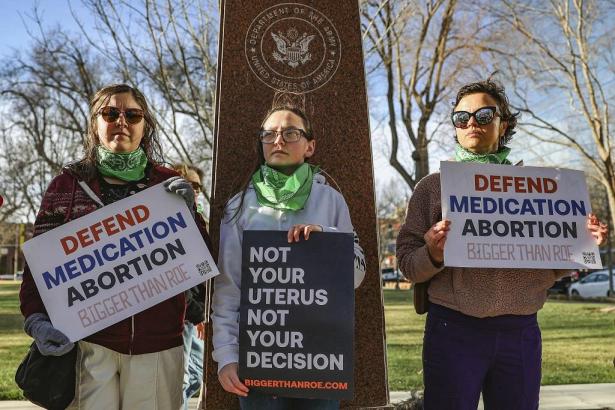It is beginning to dawn on Republican strategists looking to contain the political damage of anti-abortion excess that the right-to-life movement has created a perverse perpetual motion machine. This struggle has long ceased to be just about abortion rights. It’s a fight about women’s health and the ethical duties of doctors—one that the right can’t win.
With contradictory rulings from federal district and appeals courts, the immediate conflict over the availability of mifepristone soon moves to the Supreme Court. On Wednesday, a three-judge panel of the Court of Appeals for the Fifth Circuit partly reversed the ruling by Judge Matthew Kacsmaryk holding that the FDA’s approval of mifepristone in 2000 was invalid. The appeals panel rejected that finding as unwarranted, but upheld the prohibition of sending mifepristone through the mail, and restricted the drug in other ways.
Meanwhile, on Thursday afternoon, another federal district judge, Thomas Rice of Washington state, in a suit brought by 18 Democratic state attorneys general, reaffirmed that mifepristone could not be restricted in those states, despite the Fifth Circuit ruling. You might think that the Supreme Court, with a 6-3 majority of right-wing justices, will go at least as far as the Fifth Circuit in making it difficult to get the drug without upending the FDA’s entire regulatory regime, as Kacsmaryk’s ruling would do. But that’s far from clear.
In the 2022 Dobbs decision, Chief Justice John Roberts tried and failed to find some middle ground. He wrote that he was reluctant to deny a woman a “reasonable opportunity to choose” whether to end a pregnancy. He added that his colleagues “display a relentless freedom from doubt on the legal issue that I cannot share.”And in the closing days of the Trump administration, Roberts refused to overturn a lower-court decision limiting the FDA’s order to make mifepristone broadly available.
If anything, Justice Brett Kavanaugh went further in his concurring opinion in Dobbs. “After today’s decision, the nine Members of this Court will no longer decide the basic legality of pre-viability abortion for all 330 million Americans,” Kavanaugh wrote. “That issue will be resolved by the people and their representatives in the democratic process in the States or Congress.”
Well, no. The issue of sly restrictions that affect women who live in firmly pro-choice states is now squarely back before the high court. They are tantamount to a national ban on abortion, something that the Supreme Court explicitly declined to order. And if Roberts and Kavanaugh are at all consistent, or if they detect the danger to their party, they will refuse the efforts by lower courts to ban mifepristone.
That, of course, would bounce this question back to the political arena, where it keeps being a sure loser for Republicans. These court decisions, combined with state efforts to require doctors to be agents of state surveillance against women, have not only alienated growing numbers of pro-choice voters, especially among the young, who grew up not thinking much about abortion rights because of the security of Roe v. Wade. The far-right courts have also outraged Big Pharma and the medical profession.
And last night, with exquisite timing, Florida Gov. Ron DeSantis signed a bill that he sought, limiting abortion in Florida to six gestational weeks, effectively banning it. The law will not take effect until reviewed by the Supreme Court.
So the civil war over reproductive rights and women’s health continues. These latest ploys may be winners inside the anti-abortion movement, but they are sure losers in the broader court of public opinion and for the Republican Party. In the meantime, needless suffering coexists with the redoubling of political struggle.
===


Spread the word